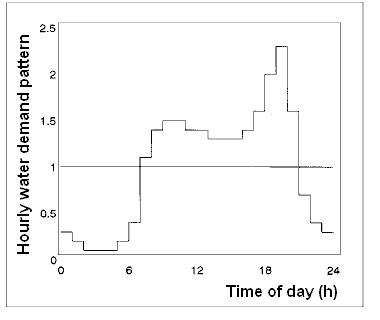Water demand in a water distribution system is not constant. It fluctuates around an annual average demand rate (G). Shorter-term variations in demand, such as day-to-day and hourly fluctuations, are important when sizing tanks in the network. The Demand Fluctuation Graphs show such variations for a typical residential area:
Demand Fluctuation Graphs


Storage tanks in the system serve the purpose of balancing out the peaks in the water demand. The conventional method for determining the required tank sizes for this purpose is extended period time simulation. For large systems such extended time simulation requires considerable amounts of computer time. This makes inclusion of time simulation into the already time-intensive enumeration algorithm employed by Wadiso impracticable. The critical period technique, a well-known technique which is used by hydrologists for yield studies of large river-dam systems, presents a much more time-efficient procedure. An adapted version of this technique has been included in Wadiso to estimate the required tank sizes for a given pipe size combination, and is described in this section under the topics:
•The basic critical period technique for a simple system
•Adjustment of the critical period technique for complex systems
•Accuracy of the critical period technique